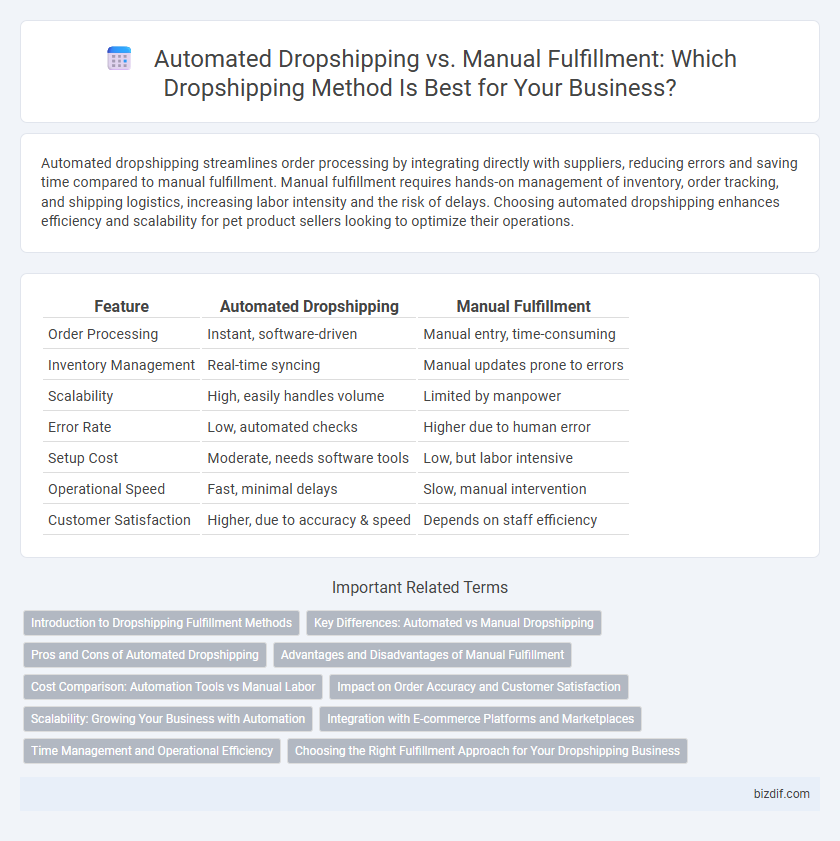Automated dropshipping streamlines order processing by integrating directly with suppliers, reducing errors and saving time compared to manual fulfillment. Manual fulfillment requires hands-on management of inventory, order tracking, and shipping logistics, increasing labor intensity and the risk of delays. Choosing automated dropshipping enhances efficiency and scalability for pet product sellers looking to optimize their operations.
Table of Comparison
| Feature | Automated Dropshipping | Manual Fulfillment |
|---|---|---|
| Order Processing | Instant, software-driven | Manual entry, time-consuming |
| Inventory Management | Real-time syncing | Manual updates prone to errors |
| Scalability | High, easily handles volume | Limited by manpower |
| Error Rate | Low, automated checks | Higher due to human error |
| Setup Cost | Moderate, needs software tools | Low, but labor intensive |
| Operational Speed | Fast, minimal delays | Slow, manual intervention |
| Customer Satisfaction | Higher, due to accuracy & speed | Depends on staff efficiency |
Introduction to Dropshipping Fulfillment Methods
Dropshipping fulfillment methods include automated dropshipping and manual fulfillment, each offering distinct advantages for e-commerce businesses. Automated dropshipping leverages software to streamline order processing, inventory updates, and supplier communication, enhancing efficiency and reducing errors. Manual fulfillment involves direct handling of orders and supplier coordination, providing greater control but requiring more time and effort from the seller.
Key Differences: Automated vs Manual Dropshipping
Automated dropshipping relies on software tools to sync inventory, process orders, and update tracking information in real-time, significantly reducing human error and operational time. Manual fulfillment requires hands-on management of orders, inventory checks, and shipment coordination, leading to higher chances of delays and mistakes. Key differences include speed, accuracy, scalability, and the reliance on technology versus manual labor in order processing and inventory management.
Pros and Cons of Automated Dropshipping
Automated dropshipping streamlines order processing and inventory management through software integration, significantly reducing manual errors and saving time. However, it requires upfront investment in reliable automation tools and may limit control over order verification and customization options. Despite these challenges, automated dropshipping enhances scalability and improves customer experience by enabling faster order fulfillment compared to manual methods.
Advantages and Disadvantages of Manual Fulfillment
Manual fulfillment in dropshipping allows for greater control over order packaging and quality assurance, ensuring a personalized customer experience. However, it often results in slower processing times and higher labor costs compared to automated systems, potentially impacting scalability. Businesses relying on manual fulfillment may face difficulties in managing large order volumes efficiently, limiting growth opportunities.
Cost Comparison: Automation Tools vs Manual Labor
Automated dropshipping significantly reduces operational costs by using software tools to manage inventory, orders, and shipping, minimizing errors and labor hours. Manual fulfillment requires consistent human intervention, increasing wages, time expenditure, and the risk of costly mistakes. Investing in automation tools often leads to higher upfront costs but delivers long-term savings and scalability compared to the variable expenses tied to manual labor.
Impact on Order Accuracy and Customer Satisfaction
Automated dropshipping significantly enhances order accuracy by minimizing human errors through seamless integration with suppliers' inventory systems, ensuring real-time stock updates and precise order processing. In contrast, manual fulfillment can lead to inventory mismatches and delayed shipments, negatively affecting customer satisfaction. Higher order accuracy in automated dropshipping directly translates to improved customer trust and repeat purchases.
Scalability: Growing Your Business with Automation
Automated dropshipping streamlines order processing, inventory management, and shipping, enabling rapid scalability by minimizing manual tasks and errors. Manual fulfillment can become a bottleneck as order volumes increase, limiting growth potential due to time-consuming, labor-intensive processes. Leveraging automation tools and software allows businesses to efficiently handle high order volumes, expanding customer reach and maximizing profit margins with consistent operational efficiency.
Integration with E-commerce Platforms and Marketplaces
Automated dropshipping streamlines order processing by seamlessly integrating with major e-commerce platforms like Shopify, WooCommerce, and marketplaces such as Amazon and eBay, reducing manual input and errors. Manual fulfillment requires individual order handling and updates, which can slow down operations and increase the risk of mistakes. Integration with platforms through automated systems enhances inventory synchronization, real-time order tracking, and faster shipping updates, driving efficiency and scalability in dropshipping businesses.
Time Management and Operational Efficiency
Automated dropshipping significantly enhances time management by streamlining order processing and inventory updates through integrated software solutions. Manual fulfillment demands more hands-on involvement, increasing the risk of errors and slower response times that hinder operational efficiency. Leveraging automation tools reduces workload and accelerates order turnaround, optimizing overall business performance.
Choosing the Right Fulfillment Approach for Your Dropshipping Business
Automated dropshipping streamlines order processing and inventory management through software integration, reducing errors and saving time, ideal for scaling businesses with high order volumes. Manual fulfillment offers greater control over customization and quality checks but demands more hands-on involvement, suitable for niche markets or startups testing product viability. Evaluating factors like order volume, budget, and desired control helps determine the most efficient fulfillment approach to optimize growth and customer satisfaction.
Automated Dropshipping vs Manual Fulfillment Infographic

 bizdif.com
bizdif.com